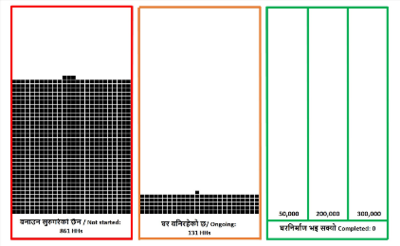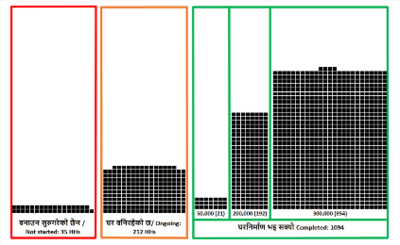Keeping track of our project activities used to entail filling out paper questionnaires and formats in the field, and then painstakingly transferring the data into a computer back at the office. Inevitably, rain, mud and human error sometimes took their toll. Digital systems of data collection, monitoring, analysis and visualization have transformed the way that we work. They offer opportunities to increase data accuracy, check progress, produce solid evidence – and save time. But what’s the best way to put in place such systems and what are the concrete gains? This is the second of three blogs exploring how we are using digital tools to improve the efficiency and effectiveness of our work in Asia.
«Many to one, one to many»
Information from multiple sources flows into one monitoring and evaluation system – be it digital or not. In earlier phases of Sharique, a local governance project in Bangladesh, several Excel-based spreadsheets carried the relevant monitoring information. To leverage data integrity, enhance collaboration, better process data and make reporting and analysis more flexible, the project moved to an online data management system.
The key point is that the monitoring data is not simply collected to meet a requirement. Instead, project staff analyze, display and use the data in tabular and graphical manners. Having one system that tracks project activities provides the right information to the right set of people at the right time. Like this, the visualized data gives a clear picture for decision-making support, reporting and communication based on evidence. In the context of Sharique, users from different levels are regularly putting information into the online system – which creates an additional feeling of ownership.
Combining tools for what they do best
While the above example illustrates a single online data management system, other projects combine tools to make the most use of what each does best. Rehabilitation of Facilities of Earthquake-Affected People (REAP) in Nepal, for instance, combined KoBo Toolbox, a free and open source software for data collection, for baseline-setting and CommCare, a commercial software, for data analysis and visualization (see below for easy visualization of project progress in reconstruction as of 23 February 2018, 13 November 2018 and then 31 May 2019, just before project closure at the end of June 2019). Enumerators could input data into KoBo even when there was no mobile reception. When the device then came within network range, the data was automatically downloaded onto the central database. Useful features of CommCare included, among others, quick identification of households in difficulty with reconstruction or grant repayment, thus allowing for rapid intervention, as well as demonstrating the (high) number of visits needed to support vulnerable/disadvantaged households.
Greater efficiency and higher impact
The Sustainable Skills and Employment in Small Scale Agro-Food Processing Project, Shamerto, in Bangladesh requires minimal time and human resources to operate their digital monitoring system compared to an analog one.
The poverty assessment tool of the project – Progress Out of Poverty Index – in conjunction with social criteria linking marginalization, categorizes beneficiaries as disadvantaged, extreme poor, poor; men and women, in line with Helvetas’ mission of supporting the poor and the disadvantaged. If we want to impact their lives, we need to identify them first. This digital tool requires a country-specific Poverty Out of Poverty Index and marginalization criteria and can then reliably, easily, quickly and spot-on identify the poorest and disadvantaged in a country-specific context, making sure that no one is left behind.
Better resource utilization
On top of positively impacting the job seekers’ income and lives – Shamerto’s digital poverty assessment tool has tremendously helped the project to efficiently use the financial resources. This is because the digital system allows for data disaggregation – specifically for the training, recruitment and job placement of women and disadvantaged jobseekers.
The Bridge Record system of the Trail Bridge Support Unit in Nepal is a web-based online system that was developed by the Government of Nepal with technical assistance from the Trail Bridge Support Unit of the Swiss Agency for Development and Cooperation, implemented by Helvetas. It tracks the condition of all 8,000 plus trail bridges across the country, along with their locations (a coordinate system using Google Maps API). Prior to the development of the system, maintenance planning was conducted in an ad hoc manner and was open to political influence. It generally only occurred after locals, elites or NGOs, who just happened to be passing by, notified the authorities of an immediate need. Now, maintenance planning is much more systematic: authorities identify bridges that require immediate action and prioritize the resource use. By identifying and addressing ‘major maintenance’ and ‘protection’ condition of bridges, they can forestall damage and prolong the life of the bridges.
Investment and sustainability
Setting up such digital monitoring systems takes time and requires adequate human and financial resources. Online systems can be new for several project staff that need to learn how to use the tools. A solid team knowing how to enter, analyze and interpret data is vital for the system’s success. As a financial investment, the project can buy tablets to collect data in the field and purchase the required licenses. A critical question is whether the project can sustain the licenses or whether it needs to discontinue them after the project ends. Keeping institutional memory of the tools and the processes is an important point when it comes to sustainability.
Helvetas’ Initiative on Digital Monitoring and Evaluation
As several Helvetas projects have put in place digital data collection and monitoring systems, the organization has embarked on a journey to develop an organization-wide system. It will encompass data collection, over data aggregation and analysis to data visualization in form of user-friendly dashboards. Investing in the digitalization of our monitoring and evaluation systems across country programs is a necessity. With such systems in place, we can better steer, advocate, understand the continuously changing context and the results of our interventions, reflect on effectiveness and learn. Digital Monitoring and Evaluation systems are one basis for successful adaptive management.






